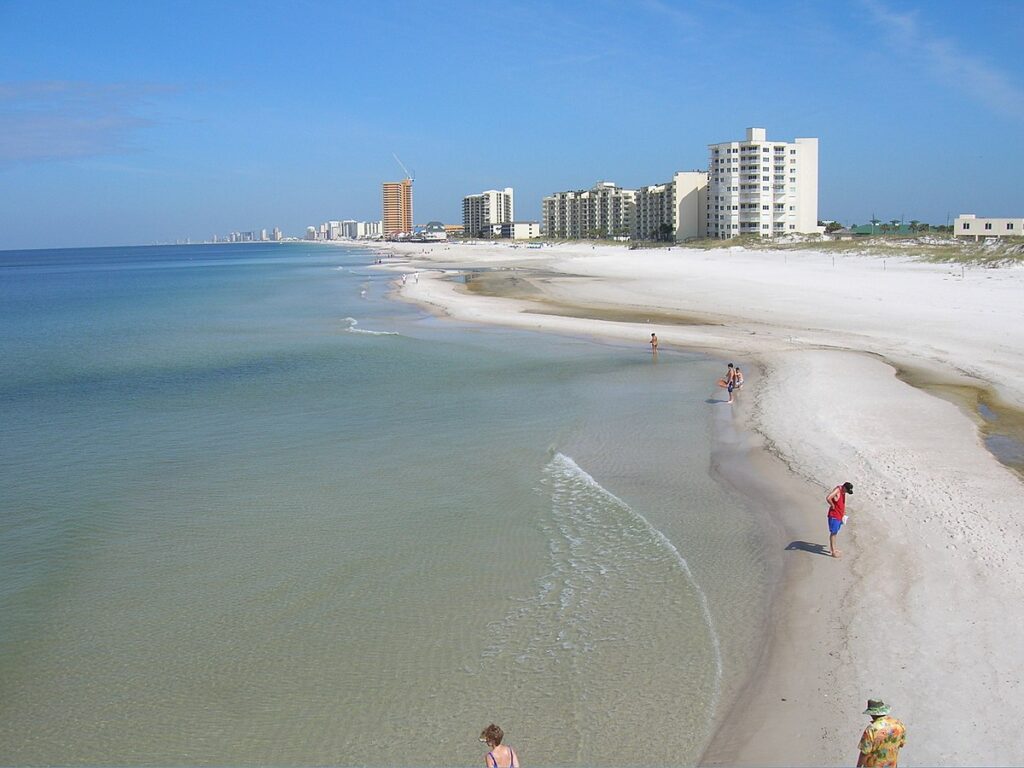
Moving to Panama City Beach, Florida: A Comprehensive Relocation Guide
Considering moving to Panama City Beach, Florida? This premier Gulf Coast destination offers white sand beaches, tourism economy, and resort lifestyle. With approximately 13,000 permanent residents in 2025, Panama City Beach combines beach town character with spring break reputation and Northwest Florida’s most famous shores.
Demographic Profile to Consider If Moving to Panama City Beach:
Panama City Beach’s 2025 permanent population is approximately 13,000 residents, though the area swells dramatically with tourists. The median age is around 44 years, with business owners, hospitality workers, retirees, and service professionals. The population is approximately 88% White, 7% Hispanic. Panama City Beach stretches along 27 miles of sugar-white sand beaches on the Gulf of Mexico, featuring resort hotels, condominiums, beach houses, and entertainment venues. Known for spring break and family beach vacations, the city attracts those seeking beach lifestyle and tourism employment. Rebuilding from Hurricane Michael in 2018 continues shaping the community. Panama City Beach appeals to beach enthusiasts, business owners in hospitality, and those accepting tourism’s seasonal nature. Find trusted local services for moving, living, and working in Panama City Beach.Panama City Beach Relocation Directory
Cost of Living to Consider If Moving to Panama City Beach:
Panama City Beach represents premium pricing for beachfront location. Median home values range from $450,000 to $700,000+ in 2025, with beachfront properties commanding significantly more. Post-hurricane rebuilding has influenced pricing and stock. The median household income is approximately $58,000, though many residents are business owners or retirees. Rental properties average $2,000 to $3,500 monthly, with vacation rental markets affecting long-term availability. Florida’s lack of state income tax provides benefit. Overall cost of living reflects beachfront location and tourism economy. Panama City Beach attracts those prioritizing beach lifestyle and tourism business opportunities. Housing costs create challenges for service workers. The combination of white sand beaches and limited beachfront land drives prices.
Economy and Job Market:
Panama City Beach’s economy revolves entirely around tourism and hospitality. Major employers include resort hotels, restaurants, attractions like Gulf World Marine Park and Pier Park shopping complex, and vacation rental management. Spring break, summer beach season, and family vacations drive the economy. Real estate and construction sectors support vacation home and condo markets. Many residents own small businesses serving tourists. The seasonal nature creates employment fluctuations. Some residents work in Panama City proper. The economy depends on tourist dollars with peak seasons determining income for many. Service industries and retail dominate employment.
Education:
Bay District Schools serves Panama City Beach students with schools including Arnold High School and Beach Elementary School. The small permanent population includes limited school-age children. Gulf Coast State College provides associate degrees. Florida State University’s Panama City campus offers programs. The educational infrastructure focuses primarily on Bay County’s larger population centers.
Recreation and Lifestyle:
Panama City Beach offers 27 miles of stunning white sand beaches and emerald-green Gulf waters. The city features Pier Park entertainment complex with shopping, dining, and attractions. Conservation Park provides 2,900 acres of trails for hiking and biking. Shell Island offers pristine undeveloped beach accessible by boat. Residents enjoy water sports, fishing, parasailing, and beach activities year-round. St. Andrews State Park nearby provides natural beauty. The lifestyle centers entirely on beach culture, tourism, and water activities. The spring break reputation creates party atmosphere March-April. The subtropical climate enables perpetual beach season. The community embraces tourism while seeking residential identity. Living in a perpetual vacation destination means accepting crowds, traffic, and seasonal nature.
Healthcare and Services:
Panama City Beach residents access healthcare through Gulf Coast Regional Medical Center and Bay Medical Center in nearby Panama City. Medical offices operate in Panama City Beach. The region’s healthcare infrastructure serves both permanent residents and tourists, with emergency services accommodating high seasonal populations.
Transportation:
Panama City Beach is accessed via U.S. Highway 98 (Front Beach Road) running along the coast and Back Beach Road providing parallel access. Northwest Florida Beaches International Airport serves the region. State Road 79 and State Road 30A provide connections. Bay Town Trolley operates seasonal beach service. Most residents use personal vehicles. Traffic congestion is significant during peak tourist seasons. The linear development makes navigation straightforward but crowded.
Conclusion:
Moving to Panama City Beach in 2025 offers beachfront living with white sand shores, tourism economy, and resort atmosphere. The city’s combination of stunning Gulf beaches, entertainment, and year-round summer makes it ideal for beach lovers, hospitality entrepreneurs, and those accepting tourism’s tradeoffs seeking Northwest Florida’s premier beach destination where every day is vacation but crowds are perpetual.

